Published
on 5
Jul 2003
|
All rights reserved.
|
|
|
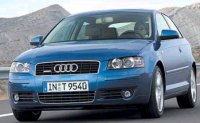 Few
car makers know platform sharing better than Volkswagen group. It
created
the world’s largest volume platform, shared by Golf IV, Bora / Jetta,
Beetle,
Audi A3, TT, Seat Toledo / Leon and Skoda Octavia, with a production
volume
exceeding 1.5 million cars a year. Among these cars, Audi A3 was the
first
to be launched. It differed from its sister cars by price (highest),
quality
(also highest) and driving manner (sportiest). These qualities earned
it
875,000 sales from 1996 to 2003. Impressive for a niche model. Few
car makers know platform sharing better than Volkswagen group. It
created
the world’s largest volume platform, shared by Golf IV, Bora / Jetta,
Beetle,
Audi A3, TT, Seat Toledo / Leon and Skoda Octavia, with a production
volume
exceeding 1.5 million cars a year. Among these cars, Audi A3 was the
first
to be launched. It differed from its sister cars by price (highest),
quality
(also highest) and driving manner (sportiest). These qualities earned
it
875,000 sales from 1996 to 2003. Impressive for a niche model.
Unsurprisingly,
the second
generation A3 from 2003 is derived from the group’s new generation A5
platform,
or more commonly known as "Golf V platform". Like last time, it beat
Golf
to make its debut, but it is not the first product of the new platform
- that is Volkswagen Touran mini-MPV. The Golf V platform is much more
sophisticated than the Golf IV. The most significant improvement is the
adoption of a fully independent 4-link rear suspension in place of the
long-serving semi-independent torsion-beam axle. It is mounted on a
sub-frame
to isolate noise, vibration and harshness from the road. Obviously, the
change is triggered by Ford Focus, whose revolutionary control-blade
suspension
enjoyed overwhelming appreciation from the world. The new Golf V
platform
also sees the use of 6-speed manual gearbox as standard and the
excellent
DSG double-clutch automated manual gearbox (from Audi TT 3.2) in top
models.
Besides, a new electro-hydraulic speed-sensitive power steering is
adopted.
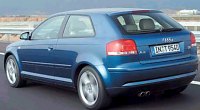 While
the chassis is undoubtedly better, the same cannot be said to the
exterior
styling. The new A3 has a more conventional, angular-looking body, more
like a Volkswagen than an Audi. It lacks the smooth-flowing design
theme
of A4, A6 and A8, confusing us whether it comes from the same
bloodline.
Drag coefficient is increased to 0.32 as a result. The nose is heavy on
details. You must praise the elegant finishing of the jewel-effect
lights,
the chromed double grilles and the carefully-shaped brake-cooling
intakes.
You must appreciate how narrow assembly gaps are and how accurately the
bonnet fit onto the top of the grille and headlamps. But you might not
like the way the lower and upper grille reassembling a single square
grille.
You had better to, because this will be the new corporate grille for
all
future Audis. While
the chassis is undoubtedly better, the same cannot be said to the
exterior
styling. The new A3 has a more conventional, angular-looking body, more
like a Volkswagen than an Audi. It lacks the smooth-flowing design
theme
of A4, A6 and A8, confusing us whether it comes from the same
bloodline.
Drag coefficient is increased to 0.32 as a result. The nose is heavy on
details. You must praise the elegant finishing of the jewel-effect
lights,
the chromed double grilles and the carefully-shaped brake-cooling
intakes.
You must appreciate how narrow assembly gaps are and how accurately the
bonnet fit onto the top of the grille and headlamps. But you might not
like the way the lower and upper grille reassembling a single square
grille.
You had better to, because this will be the new corporate grille for
all
future Audis.
In
contrast to
the nose,
the hatchback is totally featureless. If I cover the 4-ring logo, you
won’t
be able to tell whether it is an Audi, a Volkswagen or a Skoda.
The
new A3 is a
little larger
than its predecessor - 65mm longer in wheelbase, for example. But I
suspect
the new Golf will be even bigger and more spacious to please mainstream
buyers. To Audi, selling point is quality and sporty character. And I
can
tell you one of them is accomplished while another is not so
successful.
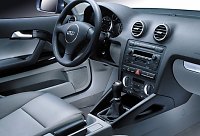 Audi’s
cabin is really in a class of its own. Even in this relatively cheap
model,
the dashboard, seats and trimming still deliver visual appeal
unrivalled
by others, BMW 3-series Compact included. Not only it employs top
quality
plastics and switches, not only it provides first class fit and finish,
but its style looks elegant, thanks to the four circular air vents
coming
from A4 Cabriolet. Alfa Romeo 147 still beats it in design, but Audi
wins
in quality. Audi’s
cabin is really in a class of its own. Even in this relatively cheap
model,
the dashboard, seats and trimming still deliver visual appeal
unrivalled
by others, BMW 3-series Compact included. Not only it employs top
quality
plastics and switches, not only it provides first class fit and finish,
but its style looks elegant, thanks to the four circular air vents
coming
from A4 Cabriolet. Alfa Romeo 147 still beats it in design, but Audi
wins
in quality.
With a 2578mm
wheelbase,
A3 offers sufficient room for 4 people. Rear passengers enjoy
noticeably
more room than Alfa 147 and BMW 3 Compact, but not necessarily a
typical
mainstream hatchback. There are many new family hatches having
2600mm-plus
wheelbase and 1500mm height (A3 is just 1421mm tall), so you won’t buy
A3 for its sheer ability to swallow people and luggage.
With
the
high-quality content,
A3 is about 50-100kg heavier than a regular family hatch. Therefore,
the
base model’s 102hp 1.6-litre 8V engine feels weak. The old 105hp
8-valve
1.9TDI engine is also unattractive. Most buyers will choose either the
150hp 2.0 FSI direct-injection petrol engine (from A4) or the new 140hp
2.0 TDI 16V with VTG (variable geometry turbine) turbocharger.
Performance
seekers with deep pocket will definitely choose the 241hp 3.2 V6 (from
Golf R32 etc.) mated with DSG 6-speed double-clutch gearbox and Haldex
4-wheel-drive. This model will top 152mph and finish 0-60mph in 6.4
second,
but it is not the flagship model yet - Audi is yet to release details
of
the forthcoming S3.
But
let us
concentrate on
the best selling 2.0 FSI and 2.0 TDI. Although the petrol engine offers
10 more horsepower, real world performance is by all means inferior to
the diesel engine. As in the A4, the 2.0 FSI has a heavy flywheel
effect
and it produces a coarse and noisy engine note at the upper rev range.
Pushing the 1275kg body, it is also not brisk enough to match the
sporty
image of Audi. On paper, the 2.0 TDI takes 0.4 more second to reach
60mph,
but its 236 lbft of torque gives it so much advantage at regular
driving
and overtaking. Its 51.4mpg consumption is also better than the FSI’s
40.9mpg
- itself is already remarkable. However, Volkswagen’s pump-injection
technology
still can’t match the latest common-rail injection technology in terms
of refinement, as measured by noise level and the vibration at start
up.
In short, both the most popular petrol and diesel engines lack
mechanical
refinement to match the high quality packaging.
Now,
you drive a
A3 2.0 FSI
or 2.0 TDI on motorway. Facing a beautiful dashboard and a high quality
environment, you discover that the cabin is well insulated from noise
despite
of that annoying engine note. The electric power steering firms up at
speed
flawlessly to raise your confidence. Damping is very good on motorway,
filtering out bumps effectively. Gearshift is positive. Brake is
strong.
You think, ‘this is a truly premium car ! it is worth the extra money.’
The end of the
motorway is
the entrance of a mountain road, then the scene is changed
dramatically.
You discover the well-weighted steering actually lacks feel, or
ridiculously,
not lack of artificial feel. Strangely, Audi has already cured this old
problem in the A4 and A8, why not the new A3? because it uses pure
electric
power steering instead of the bigger cars' electro-hydraulic steering.
The former is cheaper, of course.
Push harder in
corners, the
A3 gives up its neutrality to mild understeer. This sounds good, but
unfortunately
it comes earlier than you would expect from a driver’s car. It neither
corners as fast nor inspires its driver as much as BMW 3 Compact or
Mercedes
C-class Sports Coupe. Sadly, its handling characteristic is more like a
European Toyota Corolla. We would like it to have harder suspension
setup,
but then Audi fears that would have driven customers away. In the same
situation, Alfa Romeo would have given up those "warm hatch buyers" and
concentrated on building up a sporty image only real enthusiasts will
appreciate.
But
that is NOT
an excuse.
I don’t understand why the expensive A3 cannot match the completeness
of
a bread-and-butter Ford Focus. The latter has real steering feel,
inspiring
handling characteristic yet ride smoother than the A3, especially when
dealing with low-speed bumps. If A3 foresee how the Golf V will drive
like,
then I should express my great disappointment. It should have better
dynamics. |
Verdict:    |
Published
on 16
Sep 2003
|
All rights reserved.
|
|
A3 3.2 Quattro
|
|
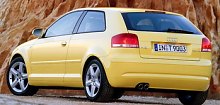 When
Audi equipped its new 3.2-litre narrow angle V6 and DSG double-clutch
6-speed
gearbox into the TT, we predicted one day the same combo would be used
in the new S3. Unfortunately, we were wrong. Wrong because this car is
not the S3, but the A3 ! yes, Audi surprised us by introducing the
250hp
V6 into the top-of-the-range A3 3.2 instead of the S3, leaving us
wondering
how powerful the new S3 will be. If you remember, the outgoing S3 had
only
225hp on tap. When
Audi equipped its new 3.2-litre narrow angle V6 and DSG double-clutch
6-speed
gearbox into the TT, we predicted one day the same combo would be used
in the new S3. Unfortunately, we were wrong. Wrong because this car is
not the S3, but the A3 ! yes, Audi surprised us by introducing the
250hp
V6 into the top-of-the-range A3 3.2 instead of the S3, leaving us
wondering
how powerful the new S3 will be. If you remember, the outgoing S3 had
only
225hp on tap.
If you have
read
my TT 3.2
report, I suppose you don't need much introduction to the V6 and DSG
gearbox.
Anyway, a brief look won't waste you too much time...
A3 3.2 is
powered
by the
company's famous 3.2-litre 15deg V6 with continuous variable valve
timing
and 2-stage variable intake. This engine also appears in Volkswagen
Phaeton
and Golf R32 in different state of tune, but the closest one is Audi
TT's,
which pumps out the same 250 horsepower and 236lbft of torque. This is
a superb engine - willing, torquey and smooth. Even better is its
companion,
the ground-breaking BorgWarner double-clutch gearbox which shifts gears
as smooth as automatic. Everybody agrees it is the gearbox of the
future.
A conventional 6-speed manual is also available, but it's certainly not
the highlight.
Of course, the
top A3 employs
Quattro system (the Haldex one) to distribute the extra power to all 4
wheels. The whole car weighs 250kg more than the front-drive A3 2.0,
but
overwhelming power means 0-60mph can be done in 6.1 seconds, claimed
Audi.
I have some reservation about that, because recently the TT 3.2 has
been
found slower than claimed. Also because Alfa Romeo 147 GTA (similarly
powerful
while being 165kg lighter) takes the same time to 60mph. However, let's
say 6.5 or 6.6 seconds, that's already quick enough for a non-S-badge
Audi.
Unfortunately, A3
3.2 only
shines in straight line. Like the rest of the range, its steering is
uninvolving.
It understeers heavily in corners, frustrating drivers who want to
exploit
the extra power and grip. Even the fine ride quality is ruined by the
stiffer
suspension setup. Sadly, the top A3 is neither a driver's car nor a
comfortable
car. Audi needs to do much better in the next S3.
|
Verdict:    |
Published
on 14
Aug 2004
|
All rights reserved.
|
|
A3 Sportback and TFSI engine
|
|
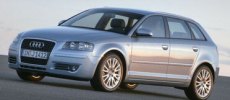 Audi
prefers to call its 5-door A3 as "Sportback". With a rear overhang
extension
of 68mm, the A3 Sportback not only carries more luggage (370 litres in
total), but its exterior design also looks halfway between a hatch and
an estate. Moreover, compare with the3-door A3 it looks more
substantial
and upmarket, more like an A4 Avant. Sportback is definitely a more
convincing
package than the 3-door. Audi
prefers to call its 5-door A3 as "Sportback". With a rear overhang
extension
of 68mm, the A3 Sportback not only carries more luggage (370 litres in
total), but its exterior design also looks halfway between a hatch and
an estate. Moreover, compare with the3-door A3 it looks more
substantial
and upmarket, more like an A4 Avant. Sportback is definitely a more
convincing
package than the 3-door.
But when
AutoZine
open a
topic for this car, it is definitely not only a door-work. In fact, we
are more interested in the new TFSI engine introduced by this car,
partly
because it will be used in the forthcoming Golf GTI. The "T" in its
name
stands for Turbo, while FSI is Volkswagen’s direct fuel injection.
Having
forgotten Mitsubuishi’s 1.8 GDI turbo used in Pajero iO - deliberately
or not, Audi incorrectly claimed this as the world’s first turbocharged
gasoline direct injection engine. Anyway, it is undoubtedly more
advanced
than the Mitsubishi engine. Based on the normally aspirated 2.0 FSI, it
lowers compression ratio to 10.5:1, strengthened the crankshaft and
pistons
and add a turbocharger. Unusually, the sophisticated top end including
2-stage intake manifolds and variable valve timing is retained, in
contrast
to most other car makers that see these technologies unnecessary for
turbocharged
engines. The fuel injection is tuned to be less stratified, biasing
more
towards performance than economy. In contrast, the turbo runs at
relatively
light pressure to ensure remarkable tractability, no wonder maximum
torque
of 207 lbft is available across a very wide band, from as low as 1800
rpm
continuously to 5000 rpm. As for power, the maximum is 200 horsepower,
from 5100 to 6000rpm. It is not very remarkable compare with Renault
Megane
Sport (225hp) or even Audi’s old 1.8 turbo (225hp), but the way it
delivers
the power is remarkably smooth and linear. It can rev to 6500 rpm
redline
without the slightest protest. What a superb engine!
Mating with DSG
gearbox,
the Sportback TFSI can sprint from rest to 60mph in 6.6 seconds and
eventually
reach a terminal velocity of 147mph. That’s not far off from the V6
Quattro.
But the TFSI is not cheap. You can get similar performance in many
cheaper
hot hatches, or much higher performance in similarly priced Japanese
rally
cars. Audi will teach you to see it as a premium car instead of
comparing
with cheaper alternatives, but then again a premium car should deliver
a more refined ride (too harsh here) and better steering (no feel
here),
just like BMW 1-series. It has a superb engine and drivetrain, but the
chassis is no where near perfect.
|
Verdict:     |
Published
on 10
Oct 2006
|
All rights reserved.
|
|
Audi S3
|
|
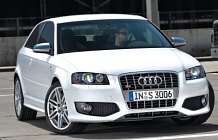 Before
buying the new S3, you had better to think twice. For £27,000,
you have plenty of choices. BMW 130i and Mercedes C350 Sports Coupe
provide similar combination of power and premium quality. Mitsubishi
Lancer Evo MR and Subaru Impreza STi trades quality for superior
performance. Opel Astra OPC offers bags of brutal fun and, may I say, a
more attractive look at only £19,000. Lastly but not least, the
duo from sister brand Volkswagen, Golf GTI and R32, smells at least as
desirable as the Audi but ask for only £20,000 and £24,000
respectively. In particular, Golf R32 has been our favourite premium
hot hatch since last year. Before
buying the new S3, you had better to think twice. For £27,000,
you have plenty of choices. BMW 130i and Mercedes C350 Sports Coupe
provide similar combination of power and premium quality. Mitsubishi
Lancer Evo MR and Subaru Impreza STi trades quality for superior
performance. Opel Astra OPC offers bags of brutal fun and, may I say, a
more attractive look at only £19,000. Lastly but not least, the
duo from sister brand Volkswagen, Golf GTI and R32, smells at least as
desirable as the Audi but ask for only £20,000 and £24,000
respectively. In particular, Golf R32 has been our favourite premium
hot hatch since last year.
Before
choosing the S3 over others, you have to ask yourself two questions: 1)
do you like its styling? 2) does its 4-cylinder engine justify the
price? to me, both answers seem to be negative. In terms of styling, S3
is far from the best effort from Audi's famous design studio. Part of
the problem is caused by the inherently unattractive shape of A3, but
even the aggressive new grille / additional air intakes / pronounced
air dams / 18-inch wheels / dual exhausts fail to turn around the
styling. For comparison, Golf R32 looks more stylish and elegant.
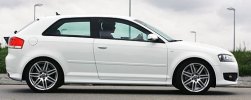 R32 also has a delicious V6
engine - like the premium rivals from BMW and Mercedes. In terms of
image, this is unquestionably a strong advantage over the 2.0 TFSI
engine of S3, which is a development from Golf GTI's unit. V6 or turbo
four, this must be a headache to Audi. On the one hand, a naturally
aspirated V6 should be smoother, more linear and more responsive in its
running, not to mention the more delicious sound it produces. On the
other hand, turbo four guarantees lighter weight at the nose hence
better chassis balance. It weighs 152kg, lighter than a comparable V6
by 20kg. Most important, at the moment Audi does not have a V6 powerful
enough for use in S3. The regular A3 3.2 Quattro already has the R32's
250hp 3.2 VR6. The 280hp 3.6 VR6 of Passat is considered to be too
heavy for the job (especially because it has cast iron block). Were
Ferdinand Piech still in charge of Audi, he might have ordered the
development of a turbocharged inline-5 engine base on the 2.0 TFSI as a
solution. However, today Audi decided to do the job in the easiest way
- increase turbo boost. R32 also has a delicious V6
engine - like the premium rivals from BMW and Mercedes. In terms of
image, this is unquestionably a strong advantage over the 2.0 TFSI
engine of S3, which is a development from Golf GTI's unit. V6 or turbo
four, this must be a headache to Audi. On the one hand, a naturally
aspirated V6 should be smoother, more linear and more responsive in its
running, not to mention the more delicious sound it produces. On the
other hand, turbo four guarantees lighter weight at the nose hence
better chassis balance. It weighs 152kg, lighter than a comparable V6
by 20kg. Most important, at the moment Audi does not have a V6 powerful
enough for use in S3. The regular A3 3.2 Quattro already has the R32's
250hp 3.2 VR6. The 280hp 3.6 VR6 of Passat is considered to be too
heavy for the job (especially because it has cast iron block). Were
Ferdinand Piech still in charge of Audi, he might have ordered the
development of a turbocharged inline-5 engine base on the 2.0 TFSI as a
solution. However, today Audi decided to do the job in the easiest way
- increase turbo boost.
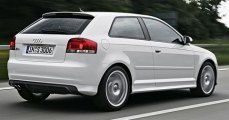 By
using bigger turbo and
intercooler, the turbocharging system can boost 1.2 bar of pressure
into combustion chambers. By using stronger block, pistons and
con-rods, the engine can withstand 258 lbft of torque generated between
2500 and 5000 rpm. By casting the cylinder head with a better alloy,
the engine can resist the heat generated by 265 horsepower at 6000 rpm,
some 25 horses more than the figure already achieved by Seat Leon Cupra
R. In other words, this is (for the time being) the ultimate version of
Volkswagen group's 2.0 TFSI engine. By
using bigger turbo and
intercooler, the turbocharging system can boost 1.2 bar of pressure
into combustion chambers. By using stronger block, pistons and
con-rods, the engine can withstand 258 lbft of torque generated between
2500 and 5000 rpm. By casting the cylinder head with a better alloy,
the engine can resist the heat generated by 265 horsepower at 6000 rpm,
some 25 horses more than the figure already achieved by Seat Leon Cupra
R. In other words, this is (for the time being) the ultimate version of
Volkswagen group's 2.0 TFSI engine.
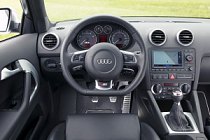 Although it is only 15hp more
powerful than Golf R32 / A3 3.2 Quattro, on the road the S3 feels far
more brutal. Its big turbo engine loses the superbly smooth and linear
manner of Golf GTI. There is some turbo lag at low rev, if not as
severe as old-school turbocharged engines. Once the needle went pass
2500 rpm, the engine starts pulling vigorously and the S3 turns into a
wild beast. Here, dominating the acceleration is not the horsepower,
but the tremendous mid-range torque which is not present in R32. The
torque is so rich that you don't need to work much on the short-throw,
slick-shifting 6-speed manual gearbox. The S3 is also 55 kilograms
lighter than R32, no wonder it dares to claim 0-60 mph in 5.4 seconds,
a decisive 0.6 seconds quicker than the Volkswagen. It is also one of
the few hot hatches capable of reaching the voluntarily regulated 155
mph. Although it is only 15hp more
powerful than Golf R32 / A3 3.2 Quattro, on the road the S3 feels far
more brutal. Its big turbo engine loses the superbly smooth and linear
manner of Golf GTI. There is some turbo lag at low rev, if not as
severe as old-school turbocharged engines. Once the needle went pass
2500 rpm, the engine starts pulling vigorously and the S3 turns into a
wild beast. Here, dominating the acceleration is not the horsepower,
but the tremendous mid-range torque which is not present in R32. The
torque is so rich that you don't need to work much on the short-throw,
slick-shifting 6-speed manual gearbox. The S3 is also 55 kilograms
lighter than R32, no wonder it dares to claim 0-60 mph in 5.4 seconds,
a decisive 0.6 seconds quicker than the Volkswagen. It is also one of
the few hot hatches capable of reaching the voluntarily regulated 155
mph.
But is it more satisfying than a V6 ? the answer is still no. The
rawness in its power delivery and engine noise is greatly at odds with
the traditional character of Audi's S-cars as well as the premium image
of the Audi brand. It would be fine for Evo or WRX, but not Audi. Golf
R32 and BMW 130i might be slower, but subjectively their 6-cylinder
engines feel sweeter and more refined. In the premium hot hatch field,
you cannot ignore these subjective qualities.
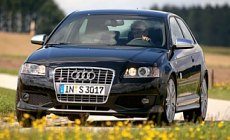 In
contrast to the engine, the chassis of S3 is every bit you would expect
for a quality hot hatch. Despite of the explosive power, the
4-wheel-drive system copes with ease. The grip, roll resistance and
braking are all first rate. The suspensions run 25mm less ride height
than the regular A3, but the combination of fine damping and more use
of aluminum components in the front suspensions (such as wishbones and
pivot bearings) help maintaining a livable ride. In
contrast to the engine, the chassis of S3 is every bit you would expect
for a quality hot hatch. Despite of the explosive power, the
4-wheel-drive system copes with ease. The grip, roll resistance and
braking are all first rate. The suspensions run 25mm less ride height
than the regular A3, but the combination of fine damping and more use
of aluminum components in the front suspensions (such as wishbones and
pivot bearings) help maintaining a livable ride.
However, you could not help feeling a little cold from the way it
drives, because this car lacks real communication with the driver. Turn
into a corner, you will find its steering feels somewhat vague, its
turn-in not as keen as the Golf duo and its brake pedal not as
feelsome. Disregarding the performance factor, the Golf duo is actually
more fun to drive.
And then you have to consider the £27,000 asking price. Before
buying the new S3, you had better to think twice. It's not bad, but
neither is it worth the price.
|
Verdict:    |
Published
on 16
Feb 2008
|
All rights reserved.
|
|
A3 Cabriolet
|
|
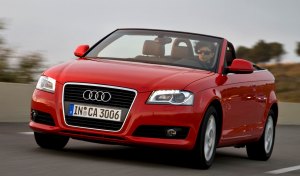
|
A3 Cabriolet has the style and quality
you would expect for Audi
|
The
Cabriolet version of
A3
comes as a surprise to me. Although it wasn't in the plan when the
current generation A3 was launched in 2003, it is surprisingly well
made. Its single-frame grille, new headlights, bumpers and taillights
deliver an upmarket image. They will be adopted by the forthcoming A3
facelift as well, but launching these styling upgrade in the Cabriolet
first help promoting its image. Audi's attention to styling details,
high-quality materials, tight assembly gaps and perfect paint finish
also help making it feeling more premium than the regular C-segment
cabriolets like Opel Astra and Ford Focus CC. Not even Volkswagen Eos
could match it. If not the short tail, you could easily confuse it with
the next generation A4 Cabriolet.
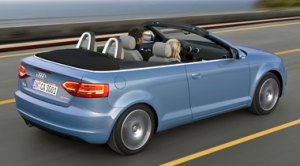
|
High chassis rigidity results in good
ride and handling
|
The A3
Cabriolet is well engineered, too. Chassis reinforcement around the
windscreen pillars, body sides, rear bulkhead and diagaonal braces
under the floorpan result in the highest rigidity in its class, so no
matter how hard you push it on B-roads you won't find the squeak and
scuttle shake that associate with many cabriolets. Well done. The
electric soft top is also well engineered. It takes only 9 seconds to
open, while the wind management and noise insulation are remarkable. I
always prefer conventional fabric roof instead of the fashionable
retractable metal roof because it is lighter and doesn't require a big
boot to store. Therefore in my opinion Audi is sensible to choose soft
top for the A3 Cabriolet. It adds only 100 kg to the kerb weight. If it
were a folding metal roof, it would have been closer to 200 kg.
Equipped with the 160 hp 1.8 TFSI engine that most people will opt for,
the A3 Cabriolet is quite brisk. 0-60 mph can be finished in 7.8
seconds, only 0.4 sec longer than the hard top version. Other engines
include 200 hp 2.0 TFSI and 105 hp 1.9 TDI.
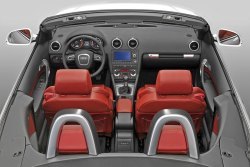
|
Soft top is a sensible choice for
weight, space and performance |
Predictably,
the rear seats are more cramped due to the strengthened bulkhead. The
seatback is nearly vertical and the legroom is tight for adults.
However, the cabin has the usual classy feel of Audi. A luggage
capacity of 260 liters is also good for a hatchback-based cabriolet.
Overall, the A3 Cabriolet is a remarkable C-segment cabriolet, if an
expensive one.
|
Verdict:     |
Published
on 22
Feb 2011
|
All rights reserved.
|
|
Audi
RS3 Sportback
|
|
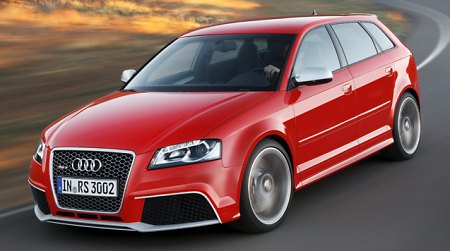
Sometimes I doubt if Audi can make money from its RS line.
Extremely powerful and quick may be, they often come late to the
party and at prices even higher than BMW M-cars. This leads to my
conclusion that Audi does not care about their earnings at all. All
it wants to do with the RS models is to establish a superior image,
very much in the style of Dr. Piech.
The latest RS3 is another example. No one else would invest so much
money into a car to be replaced in a year's time – in this case the
8-years old A3. Anyway, Ingostadt has the money and its Quattro GmbH
engineers seem to have spare time recently, so the RS3 is built to
satisfy their own desire. As
expected, its specifications are high. Power comes from the same 340hp
2.5-liter five-cylinder turbo engine as TT RS. Gearbox is a 7-speed
dual-clutch, not the one being used by RS5, but a new transverse unit
suitable to the PQ35 platform. Power goes to all four
wheels through the so-called Quattro system, which is basically the
same as the 4motion system on Volkswagen Golf R. 4th gen Haldex
multi-plate clutch distributes drive to the rear wheels much more
quickly than ever. Performance is astonishing – 0-60 mph is
claimed to take 4.4 seconds only, the same time as R8 !! though top
speed
is limited to 155 mph.
The chassis gets similar beef-up. Front track is widened by 22 mm,
which
necessitates those flared carbon-fiber front fenders. Ride height is
set a further 5 mm lower than the already sporty S3. The suspensions
employ stiffer
springs, dampers and
anti-roll bars. Larger brakes come straight from TT RS.
Surrounding them are 19-inch alloys shod with 235/35ZR19 and
225/35ZR19 tires – unusually, those front rubbers are made wider than
the
rears in order to improve front end bite and cure understeer.
Oddly, the RS3 is available exclusively in the form of 5-door
Sportback. This
explains why it
weighs some 120 kg more than the 3-door S3, or 100 kg heavier than the
equivalent TT RS.
On the road, the RS3 is fast and unflappable in everywhere. Given its
4-wheel traction,
grippy footwear and strong brakes, you will need to do foolish things
to spoil its handling. The wide front rubbers make it more eager to
turn in than the S3. Body control and precision are also taken to a
higher level. Free
of torque steer and wheel spin put it well above front-drive hot
hatches like Ford Focus RS
for dynamic fineness. On the downside, its biggest flaw is again the
steering, which delivers little information from the front wheels. Its
handling also lacks the mid-corner adjustability of Mitsubishi Lancer
Evo.
These two factors make it less fun to drive at the limit. Besides,
ride quality is likely to be very hard due to
those low-profile tires, though no one can verify that yet because Audi
cleverly chose the snowy ground of Canada to make its debut.
The high-boost 5-cylinder engine is punchy yet surprisingly flexible.
Its sound combines characterful 5-pot rhythm and old-school turbo
whoosh on over rev. In sport mode the exhaust note becomes even more
thunderous, so hardcore drivers will love it. In
contrast, the 7-speed S-Tronic gearbox is almost
civilized, making gearshift slickly and responsively.
The RS3 is very fast, of course. It is easily faster than Focus RS,
Golf R and, on straight line at least, Evo and
STi. However, it is definitely not
as quick as what you would think for a car capable of 0-60 in 4.4
seconds. Don't try to challenge a Porsche 911 Carrera S on the road,
because by the time you reach 100 mph you will
be at least 2 seconds behind the Porsche. Also bear in mind that Audi's
performance claims are usually optimistic. The RS3 is best seen as a
Focus RS+ rather than a 911 fighter.
My biggest concern is price. At £40,000, the RS3 is clearly
overpriced for a hot hatch, especially one that fails to deliver
class-leading driver entertainment. Sometimes more does not equal
better.
|
Verdict:     |
|